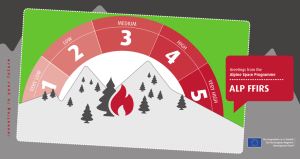Distribution and characteristics of aquatic habitats of newts and
advertisement
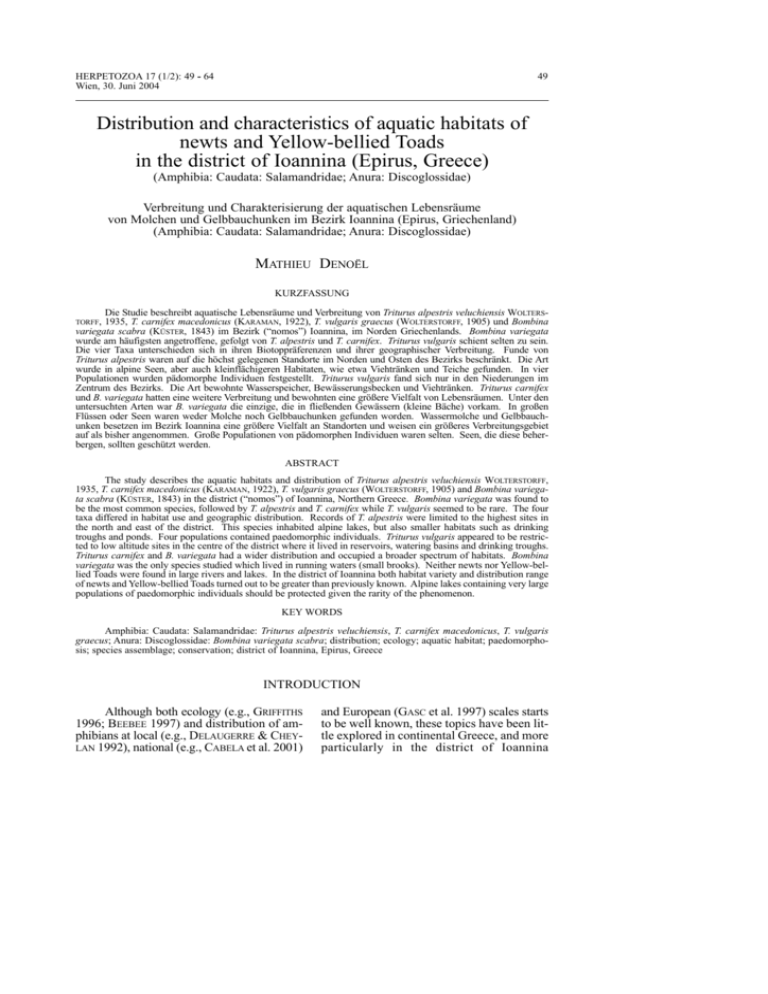
HERPETOZOA 17 (1/2): 49 - 64 Wien, 30. Juni 2004 49 Distribution and characteristics of aquatic habitats of newts and Yellow-bellied Toads in the district of Ioannina (Epirus, Greece) (Amphibia: Caudata: Salamandridae; Anura: Discoglossidae) Verbreitung und Charakterisierung der aquatischen Lebensräume von Molchen und Gelbbauchunken im Bezirk Ioannina (Epirus, Griechenland) (Amphibia: Caudata: Salamandridae; Anura: Discoglossidae) MATHIEU DENOËL KURZFASSUNG Die Studie beschreibt aquatische Lebensräume und Verbreitung von Triturus alpestris veluchiensis WOLTERS1935, T. carnifex macedonicus (KARAMAN, 1922), T. vulgaris graecus (WOLTERSTORFF, 1905) und Bombina variegata scabra (KÜSTER, 1843) im Bezirk (“nomos”) Ioannina, im Norden Griechenlands. Bombina variegata wurde am häufigsten angetroffene, gefolgt von T. alpestris und T. carnifex. Triturus vulgaris schient selten zu sein. Die vier Taxa unterschieden sich in ihren Biotoppräferenzen und ihrer geographischer Verbreitung. Funde von Triturus alpestris waren auf die höchst gelegenen Standorte im Norden und Osten des Bezirks beschränkt. Die Art wurde in alpine Seen, aber auch kleinflächigeren Habitaten, wie etwa Viehtränken und Teiche gefunden. In vier Populationen wurden pädomorphe Individuen festgestellt. Triturus vulgaris fand sich nur in den Niederungen im Zentrum des Bezirks. Die Art bewohnte Wasserspeicher, Bewässerungsbecken und Viehtränken. Triturus carnifex und B. variegata hatten eine weitere Verbreitung und bewohnten eine größere Vielfalt von Lebensräumen. Unter den untersuchten Arten war B. variegata die einzige, die in fließenden Gewässern (kleine Bäche) vorkam. In großen Flüssen oder Seen waren weder Molche noch Gelbbauchunken gefunden worden. Wassermolche und Gelbbauchunken besetzen im Bezirk Ioannina eine größere Vielfalt an Standorten und weisen ein größeres Verbreitungsgebiet auf als bisher angenommen. Große Populationen von pädomorphen Individuen waren selten. Seen, die diese beherbergen, sollten geschützt werden. TORFF, ABSTRACT The study describes the aquatic habitats and distribution of Triturus alpestris veluchiensis WOLTERSTORFF, 1935, T. carnifex macedonicus (KARAMAN, 1922), T. vulgaris graecus (WOLTERSTORFF, 1905) and Bombina variegata scabra (KÜSTER, 1843) in the district (“nomos”) of Ioannina, Northern Greece. Bombina variegata was found to be the most common species, followed by T. alpestris and T. carnifex while T. vulgaris seemed to be rare. The four taxa differed in habitat use and geographic distribution. Records of T. alpestris were limited to the highest sites in the north and east of the district. This species inhabited alpine lakes, but also smaller habitats such as drinking troughs and ponds. Four populations contained paedomorphic individuals. Triturus vulgaris appeared to be restricted to low altitude sites in the centre of the district where it lived in reservoirs, watering basins and drinking troughs. Triturus carnifex and B. variegata had a wider distribution and occupied a broader spectrum of habitats. Bombina variegata was the only species studied which lived in running waters (small brooks). Neither newts nor Yellow-bellied Toads were found in large rivers and lakes. In the district of Ioannina both habitat variety and distribution range of newts and Yellow-bellied Toads turned out to be greater than previously known. Alpine lakes containing very large populations of paedomorphic individuals should be protected given the rarity of the phenomenon. KEY WORDS Amphibia: Caudata: Salamandridae: Triturus alpestris veluchiensis, T. carnifex macedonicus, T. vulgaris graecus; Anura: Discoglossidae: Bombina variegata scabra; distribution; ecology; aquatic habitat; paedomorphosis; species assemblage; conservation; district of Ioannina, Epirus, Greece INTRODUCTION Although both ecology (e.g., GRIFFITHS 1996; BEEBEE 1997) and distribution of amphibians at local (e.g., DELAUGERRE & CHEYLAN 1992), national (e.g., CABELA et al. 2001) and European (GASC et al. 1997) scales starts to be well known, these topics have been little explored in continental Greece, and more particularly in the district of Ioannina 50 M. DENOËL (Epirus). Moreover, the Balkan Peninsula is a hotspot of biodiversity, containing a high number of endemic taxa which have not been studied intensively yet (GASC et al. 1997; MYERS et al. 2000). Knowledge of habitat use and local status of these populations is needed to better understand the ecology of the taxa, and from a larger point of view, the adaptation of amphibians to supraMediterranean and montane environments. It will also be beneficial for the application of conservation measures to a class of animals in decline all over the world (e.g., HOULAHAN et al. 2000), including the Balkans (KALEZIC & DZUKIC 2001). The district of Ioannina is bordered by Albania in the north and six Greek districts. Elevations are highest in the north and east in the Gramos, Smolikas, Tymphi (Gamila), Mavrovouni, and Lakmos mountain massifs (fig. 1). Smolikas, Gramos, and Tymphi, the three highest summits, reach 2,637 m, 2,520 m and 2,497 m a.s.l., respectively, but the bottoms of the large valleys are below 500 m elevation. Kasidiaris, Mitsikeli and Tomaros are hills in the centre and west of the district. Most of these mountainous areas are part of the North Pindos, with the exception of Tomaros and Lakmos, which belong to the South Pindos (SFIKAS 1980). Two national parks have been designated in Ioannina: Vikos-Aoos and Valia Calda, also called Pindos (HANDRINOS & AKRIOTIS 1997). Ten amphibian taxa are known from the district of Ioannina: Bombina variegata scabra (KÜSTER, 1843), Bufo bufo spinosus DAUDIN, 1803, Bufo viridis viridis LAURENTI, 1768, Hyla arborea arborea (LINNAEUS, 1758), Rana ridibunda PALLAS, 1771 (Rana balcanica SCHNEIDER, SINSCH & SOFIANIDOU, 1993, junior synonym for Rana kurt- muelleri GAYDA, 1940 is considered a synonym of Rana ridibunda: OHLER 1997; PLÖTNER & OHST 2001), R. epeirotica SCHNEIDER, SOFIANIDOU, KYRIAKOUPOULOU-SLAVOUNOU, 1984, R. graeca BOULENGER 1891, Salamandra salamandra salamandra (LINNAEUS, 1758), Triturus alpestris veluchiensis WOLTERSTORFF, 1935, T. carnifex macedonicus (KARAMAN, 1922) (CYRÉN 1935; SCHNEIDER et al. 1984; SMIRINA & SOFIANIDOU 1985; BREUIL & PARENT 1987; CRUCITTI & GENTILI 1987; CRUCITTI & TRINGALI 1987; ADAMAKOPOULOS & HATZIRVASANIS 1988; BREUIL & PARENT 1988; PAPAIOANNOU 1988; SOFIANIDOU & SCHNEIDER 1989; GRILLITSCH & GRILLITSCH 1991; BREUIL 1992; SCHNEIDER & SINSCH 1992; SCHNEIDER et al. 1993; SOFIANIDOU et al. 1994; BRINGSØE 1995; KYRIAKOPOULOU-SKLAVOUNOU et al. 1997; PÉREZ MELLADO et al. 1999; DENOËL et al. 2001; PLÖTNER & OHST 2001; DENOËL 2003; DENOËL & SCHABETSBERGER 2003; DENOËL et al. 2004). Paedomorphosis has been found in some populations of Triturus alpestris veluchiensis inhabiting the district (SMIRINA & SOFIANIDOU 1985; BREUIL & PARENT 1987; BREUIL 1992; DENOËL et al. 2001; DENOËL 2003; DENOËL & SCHABETSBERGER 2003; DENOËL et al. 2004). Rana dalmatina BONAPARTE, 1840, Pelobates syriacus balcanicus KARAMAN, 1928, and Triturus vulgaris graecus (WOLTERSTORFF, 1905) have been known from North-West Greece (BOUSBOURAS & IOANNIDIS 1997a, 1997b), thus, their occurrence in the district of Ioannina was to be expected. The aim of this study was to contribute to the knowledge of the biogeography and the status of the three species of newt and the Yellow-bellied Toad of the district of Ioannina in providing data on their populations, aquatic habitats and distribution. MATERIALS AND METHODS In the administrative district (“nomos”) of Ioannina water bodies inventoried for the presence of amphibians from 6 July to 26 August 1999 were found in following the roads of the district. High altitude lakes were localized on the topographical maps of the Hellenic Army Geographical Service. The description of the habitat is given in the “results” section. In most cases, surface area of the aquatic habitats was measured and water depth determined with a plumb line (following parallel transects across the water sites). The present study is focused on Triturus alpestris, T. vulgaris, T. carnifex and Bombina variegata that are usually present in the water until summer while adults of the other species, such as B. viridis, H. arborea, R. ridibunda, R. epeiro- Distribution and habitat of newts and Yellow-bellied Toads in Northern Greece tica and R. graeca leave the water earlier (ASIMAKOPOULOS et al. 1990; KYRIAKOPOULOU-SKLAVOUNOU 2000). The presence of 51 newt larvae and recently metamorphosed yellow-bellied toad juveniles has also been recorded. Fig. 1: Studied localities in the district of Ioannina (Greece). See table 1 for details. Abb. 1: Untersuchte Standorte im Bezirk Ioannina (Griechenland): siehe auch Tabelle 1. 52 M. DENOËL Amphibians were counted by sight or caught by landing net and minnow traps. In two alpine lakes, capture-mark-recapture methods were applied to estimate population size (Petersen index) (DENOËL & SCHABETSBERGER 2003). For that purpose, individuals were marked by tattooing with Alcian blue (JOLY & MIAUD 1989). Amphibians were temporarily maintained in containers filled with water. They were released in their natural habitat after observation. Paedomorphic newts were distinguished from metamorphic newts by the presence of gill slits and three pairs of external gills, from larvae by the presence of a developed cloaca. Universal Transverse Mercator projection was used to specify the position of the newts with an accuracy of 1 km (World Geodetic System 1984 Ellipsoid). The district of Ioannina falls within the 34S and 34T UTM grid zones. Its surface area is 4,990 km². Distribution maps were drawn from Tactical Pilotage Charts 1:500,000 (G3A and F3D) and from the administrative map of nomos Ioannina 1:200,000. The position of the aquatic sites was determined by using a Global Positioning Device (Garmin® II Plus) and topographical maps. When amphibians were found in more than one aquatic habitat at the same place (e.g., in a drinking trough and a nearby reservoir), they were given identical site numbers in the text and table 1, however supplemented by different accessorial letters (e. g., “a” and “b”) to distinguish them. RESULTS AND DISCUSSION I found newts and/or Yellow-bellied Toads in 56 locations (62 stations when considering different habitats located at the same place) in the administrative district (“nomos”) of Ioannina (table 1, fig. 1). Amphibians were present in the mountain massifs of Gramos, Smolikas, Tymphi, Mavrovouni, Kasidiaris, Mitsikeli, Lakmos and Tomaros. Some populations were also observed at the border or outside these mountainous chains. In most of the 62 studied stations (69%) I found only one amphibian species among the four species studied, in others two (27%) or three (3%). Bombina variegata was the most common taxon (in 79% of the stations), followed by T. carnifex and T. alpestris (24% and 23%, respectively). Triturus vulgaris (here mentioned from the district for the first time) seemed uncommon (8%) at the time of the year. In terms of apparent populations size, T. alpestris was by far the most abundant taxon (e.g., more than twenty thousands in a single alpine lake) while, in other species, less than 100 individuals and even often only a few adults were found per site. Yellow-bellied Toads and newts were found in different kinds of aquatic habitats (table 1; fig. 2), large rivers (Aoos, Voidomatis, Sarandaporos, Kalamas) and large natural and artificial lakes (Pamvotidis = ”Ioannina” and Aoou) excluded. Aquatic habitats Bombina variegata was the only amphibian found in brooks (fig. 3a). Water level of these brooks was relatively low (a few cm in some of them; maximum: 70 cm at one site) due to summer drought; some of them contained also fishes, crayfish and crabs. Other brooks were totally dried out. Although being a rather exceptional phenomenon, T. alpestris has been known to occur in running waters in Greece (BREUIL & PARENT 1987, pers. obs.), including in the Tymphi mountains (BREUIL & PARENT 1987), but was not recorded in this kind of habitat during this study. Watering basins are man-made reservoirs bordered with gentle slopes (fig. 3c), typically circular in shape, built in concrete and used to water cattle (however, not always directly accessible to it). Although water level decreases during hot periods, the reservoirs are usually filled all the year, providing a safe place for amphibian development. Their depth ranged between 50 and 100 cm. They were mostly inhabited by Triturus carnifex and T. vulgaris, but rarely by T. alpestris and B. variegata. Green frogs (Rana sp.), Natrix natrix persa (PALLAS, 1814) and Emys orbicularis hellenica (VALENCIENNES, 1832) also used this habitat. Distribution and habitat of newts and Yellow-bellied Toads in Northern Greece 53 Fig. 2: Aquatic breeding habitats of Triturus alpestris, T. carnifex, T. vulgaris and Bombina variegata in the district of Ioannina (Greece). Abb. 2: Aquatische Lebensräume von Triturus alpestris, T. carnifex, T. vulgaris sowie Bombina variegata im Bezirk Ioannina (Griechenland). Reservoirs are man-made basins, built in concrete with vertical walls. Their shape is quadrangular. Cattle has no access to reservoirs. This habitat was mainly occupied by T. carnifex and T. vulgaris. Some of the reservoirs may constitute a trap for amphibians, particularly for Yellow-bellied Toads. They were usually deep (1 to 2.5 m) and provided water for amphibians during summer. Drinking troughs are shallow (20-30 cm water depth) man-made habitats (fig. 3b), sometimes in connection with reservoirs or springs. They may have replaced small primary habitats (springs, small ponds) in some cases. Troughs are usually of elongated rectangular shape and sometimes elevated above the bottom which means that amphibians have to climb vertical walls to reach it. This habitat was inhabited by B. variegata and the three newt species. It is usually not a trap for newts, which easily climb vertical structures (pers. obs.). 54 M. DENOËL Table 1 (this and opposite page): Stations in the district of Ioannina (Greece) where newts and Yellow-bellied Toads where found in the present study. UTM - Universal Transverse Mercator grid (1 x 1 km); T. - Triturus, B. - Bombina; Alt - altitude (m); Surf - water body surface (m2); Depth - maximum water depth (cm); A - adults, J - metamorphosed juveniles, L - larvae. Site/Stelle Locality/Fundort Mountain/Gebirge UTM Alt Surf 1 2 3 4 5 6 7 8 9a 9b 10 11 12 13 14 15 16 17 18 19 20 21 22 23 24 25 26 27a 27b 28 29 30a 30b 31 32 33a 33b 34 35 36 37 38 39 40a 40b 41 42 43 44 45 46a 46b 47 48 49 50 51 52 53 54 55 56 Plikati Oxiron Farmaki (1) Farmaki (2) Aetomilitsa (1) Aetomilitsa (2) Paliovoulia (Vasi Rema) Paliovoulia Langada (1a) Langada (1b) Langada (2) Langada (3) Fourka (1) Fourka (2) Fourka (3) Exohi Grolliorracha Micrilimni Drakolimni Metra Toska Pogogniani Vissani Agios Posmas Geroplatanos Aristi Micro-papingo (1) Xerolimni Valtos (=Rizina) (a) Valtos (=Rizina) (b) Drakolimni Loutsa Rabozi Kalivia (a) Kalivia (b) Elafotopos (1) Elafotopos (2) Monodendri (1a) Monodendri (1b) Monodendri (2) Tsepelovo Lakkoboui – Stani Trava Lavdani Aetopetra Asprangeli Paliochori (a) Paliochori (b) Kipi (Riziana 1) Kipi (Riziana 2) Leptocaria (1) Leptocaria (2) Stavros Manassis (a) Manassis (b) Neochori Kalivari (1) Kalivari (2) Krapsi (1) Krapsi (2) Agh. Anastasia (1) Agh. Anastasia (2) Baousii K. Asprochori Elafos Gramos Gramos Gramos Gramos Gramos Gramos Gramos Gramos Smolikas Smolikas Smolikas Smolikas Smolikas Smolikas Tymphi Tymphi Tymphi Tymphi Tymphi Tymphi Tymphi Tymphi Tymphi Tymphi Tymphi Tymphi Tymphi Tymphi Kasidiaris Kasidiaris Mitsikeli Mitsikeli Mitsikeli Mavrovouni Mitsikeli Mitsikeli Mitsikeli Mitsikeli Lakmos Lakmos Tomaros Tomaros Tomaros Tomaros Tomaros 34T-0480-4459 34T-0483-4460 34T-0485-4464 34T-0486-4464 34T-0486-4463 34T-0486-4463 34T-0488-4459 34T-0488-4458 34T-0488-4452 34T-0488-4452 34T-0489-4450 34T-0489-4449 34T-0493-4447 34T-0494-4445 34T-0498-4442 34T-0477-4439 34T-0477-4436 34T-0492-4439 34T-0492-4437 34T-0490-4435 34S-0450-4426 34S-0460-4420 34S-0462-4424 34S-0465-4425 34S-0473-4421 34S-0477-4424 34S-0480-4426 34S-0480-4426 34S-0480-4426 34S-0481-4427 34S-0484-4418 34S-0469-4417 34S-0469-4417 34S-0471-4418 34S-0471-4418 34S-0477-4414 34S-0477-4414 34S-0477-4414 34S-0484-4418 34S-0485-4419 34S-0458-4406 34S-0460-4403 34S-0476-4409 34S-0476-4410 34S-0476-4410 34S-0486-4408 34S-0487-4408 34S-0492-4408 34S-0492-4408 34S-0517-4413 34S-0484-4404 34S-0484-4404 34S-0477-4399 34S-0491-4400 34S-0491-4400 34S-0502-4388 34S-0503-4389 34S-0478-4380 34S-0477-4379 34S-0476-4377 34S-0476-4371 34S-0476-4366 1100 1560 1830 1790 1700 1550 1190 1050 820 820 1160 1250 1640 1440 1700 680 740 2100 2140 1430 760 820 580 570 720 1180 1770 1750 1750 2000 1975 620 620 980 960 1120 1120 1140 1280 1400 720 860 920 870 870 880 880 1000 1000 1660 1080 1080 480 640 640 640 1000 520 560 720 500 620 7 3000 3 0.6 28 3 400 7 28 90 1500 7000 2 50 100 100 5 3 1000 25000 10000 300 7 64 300 64 300 15 450 64 1.5 10 7 4 12 - Distribution and habitat of newts and Yellow-bellied Toads in Northern Greece 55 Tab. 1 (diese und gegenüberliegende Seite): Fundorte von Molchen und Gelbbauchunken im Bezirk Ioannina im Rahmen dieser Studie. UTM - Universal Transverse Mercator–Raster (1 x 1 km); Alt - Seehöhe (m); Surf - Gewässeroberfläche (m2); Tiefe - maximale Gewässertiefe (cm); T. - Triturus, B. - Bombina; A - erwachsene Tiere; J - metamorphosierte Jungtiere; L - Larven. Site/Stelle Depth/Tiefe Habitat 1 2 3 4 5 6 7 8 9a 9b 10 11 12 13 14 15 16 17 18 19 20 21 22 23 24 25 26 27a 27b 28 29 30a 30b 31 32 33a 33b 34 35 36 37 38 39 40a 40b 41 42 43 44 45 46a 46b 47 48 49 50 51 52 53 54 55 56 50 >250 30 30 130 30 5 30 60 70 30 495 20 100 50 30 30 50 100 100 370 30 50 30 20 100 20 20 >60 250 20 25 12 2 4 50 5 70 3 >100 10 drinking trough ditch lake puddle-pond puddle-pond pond drinking trough pond-swamp drinking trough spring drinking trough ditch drinking trough watering basin pond drinking trough drinking trough pond lake brook drinking trough watering basin reservoir watering basin drinking trough drinking troug pond swamp/spring brook lake pond watering basin drinking trough reservoir watering basin reservoir drinking trough watering basin watering basin drinking trough brook pond reservoir reservoir drinking trough brook brook pond pond drinking trough drinking trough brook drinking trough brook brook drinking trough spring-pond brook brook reservoir brook reservoir T. alpestris 67 A 3 A, 50 L 12 L 11 A, >100 L 1L T. carnifex T. vulgaris 1A 6L 3 A, 4 J 1A 11 A, 7 J 15 L >50 L 2 A, >200 L 3A 6 A, 21 L 26111 A 2A 4 A, 1 J 5A 2A 2A 8A 1A 1 A, 2 J >500 L 3A 1L 1A 10 A, 10 J 10 A >20 A 5A >56 A 5491 A, >50 J >200 A B. variegata 10 A 7A 3A 7A 3 A, 5 J 8A 2A >30 A, >30 L 1A 1A 2A 50 A, >500 L 9A 5A 7A 1A 5A 1 A, 10 L 7J 1 A, 1 L 1 A, 1 L 3A 15 A 5A, 30 J 10 A 10 A, >200 J 1J 4 A, 1 J 7 A, > 40 J 5A 10 A, 1 J 10 A 15 A, 5 J 1 A, 1 J 4A 6A 3A 2 A, 1 J A 3 A, 3 J 1A 5A 1 A, 1 J 1A 1 A, 1 J 10 A, 1 J 56 M. DENOËL Alpine lakes are usually deep (maximum recorded depth: 4.95 m) oligotrophic natural water bodies in high elevations (fig. 3d). Most were inhabited by T. alpestris, and some B. variegata and T. carnifex. Bufo viridis was also observed in such sites. Other aquatic habitats assessed were ponds, puddles, springs, swamps and ditches. Some ponds were used for the same purpose as watering basins but did not have an artificial coating. Various ponds and swamps were relatively deep (around 1 m), but not so springs and ditches (less than 20 cm depth). While all these water bodies can be inhabited by B. variegata, T. carnifex and T. vulgaris were never found in ditches and puddles. Fifty-seven percent of the aquatic habitats where newts and Yellow-bellied Toads were found were artificial (reservoirs, watering basins, drinking troughs) (table 1). They were built to assure water reserves for stock farming. Human activities have thus favoured the presence of amphibians in such relatively dry habitats. Most likely they allow for a larger range and potentially a better connectivity between natural sites (brooks, ponds and lakes) in the district of Ioannina. Because T. vulgaris was only found in man-made habitats, it is at risk of extinction in the district if such artificial environments disappeared. After all, the development of new agricultural practices using automatic water delivery or the construction of closed reservoirs constitute a threat to amphibians. BOUSBOURAS & IOANNIDIS (1987a) report on draining and pumping activities and the imission of pesticides in the Prespa area (Northern Greece). Draining and pumping do not seem to be important threatening factors to newts and Yellow-bellied Toads in the district of Ioannina, whereas such techniques may be detrimental to amphibian species which live close to large areas of cultivated land. In seventeen sites assessed, neither newts nor Yellow-bellied Toads were found, whereas other amphibians were present. This was the case in large rivers (e.g., Aoos) or canals that are inhabited by green frogs, but also in some brooks, reservoirs, watering basins, drinking troughs, and ponds some of which containing fishes. Altitudinal distribution The four studied amphibian species significantly differed by their altitudinal range (Kruskal-Wallis H-test, p = 0.001; fig. 4). The median altitudinal locations were 1,725 m for T. alpestris, 1,080 m for B. variegata, 950 m for T. carnifex, and 920 m for T. vulgaris. Triturus alpestris occurred in higher places than the three other species (Mann-Whitney U-test, p < 0.05). The other comparisons, i.e. between T. carnifex and T. vulgaris, T. carnifex and B. variegata, and T. vulgaris and B. variegata are not significant, indicating similar altitudinal distribution ranges (Mann-Whitney U-test). Species assemblages The most frequent species association in the district of Ioannina was that of T. alpestris and B. variegata (11 stations), the others were communities of T. carnifex and B. variegata (5 stations), T. vulgaris (4 stations) and T. alpestris (3 stations). Triturus vulgaris was never seen in syntopy with T. alpestris or B. variegata (table 1). Other amphibian species were also associated with the four species considered in this study. Green frogs (Rana ridibunda or R. epeirotica) were the most common syntopic species (19 stations out of 62), particularly with T. carnifex (9 stations) and B. variegata (8 stations). Syntopic green frogs inhabited various habitats: lakes, ponds, watering basins, drinking troughs, and reservoirs. Bufo v. viridis was also found at high elevations syntopically with T. alpestris and B. variegata. Syntopies also concerned R. graeca, S. s. salamandra, H. a. arborea, and B. bufo spinosus. Newt assemblages are common in Europe (GRIFFITHS 1996), with up to five species inhabiting the same pond in Western France (ARNTZEN & DE WIJER 1989). In such cases, each taxon is expected to differentially use the available resources (JOLY & GIACOMA 1992). Such resource partitioning decreases interspecific competition and favours coexistence. However, newt species can also segregate in habitat selection (SCHOORL & ZUIDERWIJK 1981). Among the three species of newts occurring in the nomos of Ioannina, there is some partition- Distribution and habitat of newts and Yellow-bellied Toads in Northern Greece 57 Fig. 3: Breeding habitats of amphibians in the district of Ioannina (Greece). A - Brook in Kipi (site 42); B - Drinking trough in Manassis, Mitsikeli (site 46); C - Watering basin in Monodendri, Tymphi (site 34); D - “Drakolimni” alpine lake, Tymphi (site 28). Abb. 3: Aquatische Lebensräume von Amphibien im Bezirk Ioannina (Griechenland). A - Bach in Kipi (Standort 42); B - Viehtränke in Manassis, Mitsikeli (Standort 46); C - Bewässerungsbecken in Monodendri, Tymphi (Standort 34); D - “Drakolimni” alpiner See, Tymphi (Standort 28). ing in altitudinal distribution and aquatic habitat selection (this study). Additionally there is time partitioning as several amphibian species breed before newts and Yellowbellied Toads do (ASIMAKOPOULOS et al. 1990; KYRIAKOPOULOU-SKLAVOUNOU & LOUMBOURDIS 1990; BOUSBOURAS & IOANNIDIS 1997a). Triturus alpestris veluchiensis WOLTERSTORFF, 1935 Greek Alpine Newts were found in 14 aquatic sites of the district, all in the northern mountainous areas: Tymphi, Smolikas, Mavrovouni and Gramos mountains (table 1, fig. 5). All stations were above 1,190 m 58 M. DENOËL a.s.l. with the highest one at 2,140 m (table 1; fig. 4). Alpine Newts frequented mainly alpine lakes, ponds and drinking troughs but also watering basins and puddles (fig. 2). Surface and maximum water depth of the aquatic sites ranged from 0.6 to 25,000 m² and from 0.3 to 4.95 m respectively. In deep alpine lakes, newts occupied all micro-habitats including the deepest layers. Sexual displays were observed in such high elevation lakes. The largest population sizes were found in the largest and deepest sites: two permanent alpines lakes, both called Drakolimni. One is located in Smolikas and the other in Tymphi. Other large populations were found at Valtos, Farmaki and Loutsa Rabozi. Only a few individuals were observed in the other sites (table 1). Drakolimni, Smolikas (site 18). This lake is the highest record location in the district of Ioannina (2,150 m elevation). Its maximum depth is 3.7 m and the surface covers 0.7 ha. It is surrounded by alpine pasture. Sheep flocks regularly used the lake for drinking. Some pine trees were present close to the lake. Size of the aquatic population was estimated at 26,111 (95 % confidence interval: 22,331 - 32,032; calculation based on a sample of 1887 adult individuals) adult Alpine Newts, including paedomorphic and metamorphic individuals (DENOËL & SCHABETSBERGER 2003). Paedomorphs constituted 74% of the adult population. Two adults of T. carnifex macedonicus were also found in the lake along with B. viridis viridis. Drakolimni, Tymphi (site 28; fig. 3d). This lake is located on a pass at an elevation of 2,000 m. The depth of the lake is 4.95 m and its surface covers 1 ha. It is surrounded by alpine pasture. A small sheep flock frequented the site on a daily basis. Size of the aquatic population was estimated at 5,491 (95 % confidence interval: 4,300 - 8,007; calculation based on a sample of 474 adult individuals) adult Alpine Newts, including both paedomorphic and metamorphic individuals (DENOËL & SCHABETSBERGER 2003). Paedomorphs constituted 34% of the adult population. Terrestrial juveniles have been found close to the lake. Bufo viridis and Bombina variegata were also present in the Drakolimni area. Valtos, Tymphi (site 27); a large, Ushaped swamp. Aquatic vegetation is dense except in a 400 m² open area. Sheep flocks used the swamp area. Consequently, the swamp floor was covered with sheep faeces. The water is very eutrophic. A cold spring (5°C) irrigates the swamp from its eastern arm, however, the water temperature in the swamp is higher (around 15°C in early August). The spring proper is 1 m deep, 2 m in diameter and its water is clear. A small river also crosses the swamp. Fifty-six adult newts were caught in the open area of the swamp, and a few individuals in the spring and vegetated areas, but the total population is larger. Both paedomorphs and metamorphs were observed. Paedomorphs constituted 34% of the adult population. Bufo v. viridis and Natrix natrix persa were also found in the swamp. Farmaki, Gramos (site 3); a 3,000 m² lake close to the crest separating Greece from Albania; it was fed by a brook, but the water in the lake was turbid. Some bulrush surrounded the lake. Sixty-seven adult Alpine Newts were caught, including both paedomorphs and metamorphs, but the population size is larger. Paedomorphs constituted 57% of the adult population. Loutsa Rabozi, Tymphi (site 29); a large pond (around 60 m long), almost dry at the end of August 1999 (1-30 cm water depth). The water is retained in the pond by an artificial dam. Aquatic vegetation is abundant. More than 200 metamorphic Alpine Newts were observed. They were mainly found along the shore. Because of the shallow depth, their backs were often above the water surface. Drying caused puddles isolated from the pond which were occupied by newts moving from hole to hole. In the district of Ioannina, the Alpine Newt was the amphibian species that has received the most attention from scientists (SMIRINA & SOFIANIDOU 1985; BREUIL & PARENT 1987; ADAMAKOPOULOS & HATZIRVASANIS 1988; BREUIL & PARENT 1988; PAPAIOANNOU 1988; BREUIL 1992; BRINGSØE 1994, 1995; SOTIROPOULOS et al. 1995; KYRIAKOPOULOU-SKLAVOUNOU et al. 1997; DENOËL et al. 2001; DENOËL 2003; DENOËL & SCHABETSBERGER 2003). BREUIL & PARENT (1987) first gave a distribution map of Alpine Newts in Greece with four sites in Distribution and habitat of newts and Yellow-bellied Toads in Northern Greece 59 Fig. 4: Altitudinal distribution (median, quartiles, range) of Triturus alpestris, T. carnifex, T. vulgaris and Bombina variegata in the district of Ioannina (Greece). Abb. 4: Vertikale Verbreitung (Median, Quartile, Spannweite) von Triturus alpestris, T. carnifex, T. vulgaris und Bombina variegata im Bezirk Ioannina (Griechenland). Smolikas and Tymphi. These four sites are still inhabited by Alpine Newts. BREUIL & PARENT (1987) found paedomorphs in Micrilimni; I only observed metamorphs there. Maybe the shallowness of the swamp inhibits permanent aquatic life at this altitude (2,150 m). ADAMAKOPOULOS & HATZIRVASANIS (1988) prospected Greek mountains and - in addition to the sites described in the present study - found four more localities for metamorphic Alpine Newts in Smolikas Mountains in the east of Drakolimni. Triturus alpestris was also found at a locality close to the Katara pass, in the east of Metsovo (G. H. PARENT, pers. comm.). The present study reports the presence of the Alpine Newt in ten more sites than described in previous studies. Moreover, in addition to the fact that Greek Alpine Newts use large natural habitats in the north of their distribution range, this study shows that small artificial aquatic habitats such as drinking troughs are also suitable breeding sites. In different environments in Central Greece and the Peloponnese, Alpine Newts have also been found in restricted artificial habitats, including ditches, drinking troughs and cement reservoirs (BRINGSØE 1985; ADAMAKOPOULOS & HATZIRVASANIS 1988; BRINGSØE 1994). Of course, population size in such water bodies is much smaller than in Alpine lakes, however, it can be sufficient to allow reproduction and may consequently be a step towards the dispersion of newts, colonisation of new areas, and recolonisation after potential catastrophes. Greek Alpine Newts have been assigned to the subspecies T. alpestris veluchiensis (WOLTERSTORFF 1905; ARANO & ARNTZEN 1987; BREUIL & PARENT 1988). However, morphologic (BREUIL & PARENT 1988; pers. obs.) and genetic (KYRIAKOPOULOU-SKLAVOUNOU et al. 1997) differentiation has been observed among the Greek populations suggesting that the situation is probably more complex. BREUIL & PARENT (1988) considered Smolikas populations to be different from the others. Smolikas and Tymphi populations are located in the Vikos-Aoos National Park. Conservation efforts should be made to protect the habitat of these probably endemic populations, which in this area exhibit colour (e. g., specimens with large black spots) and developmental (paedomorphs) variants. 60 M. DENOËL Triturus vulgaris graecus (WOLTERSTORFF, 1905) Smooth Newts were found in only five sites, in hilly areas at the west border of the Tymphi and Mitsikeli mountains (table 1; fig. 5). The altitudinal distribution ranged from 480 m to 980 m (fig. 4). Smooth Newts inhabited reservoirs, watering basins and drinking troughs (fig. 2). Surface and maximum water depth of the aquatic sites ranged from a few square meters to 450 m2 and from 0.2 to 2.5 m respectively. Only a few individuals were found at each station. This is the first account on the presence of the Smooth Newt in the district of Ioannina. Both number of populations and population size observed were small. Population size was probably slightly underestimated given that Smooth Newt adults had almost finished breeding activities at the time of my visit and some of them left the water. BOUSBOURAS & IOANNIDIS (1997a) reported Smooth Newts to inhabit streams and cold waters. However, I found only frogs, toads and salamanders in running waters. Moreover, my observations show that Smooth Newts preferred the warmer sites in the district of Ioannina. The absence of the Smooth Newt from Alpine lakes is most probably due to its avoidance of cold high altitude environments (KUZMIN & ZUIDERWIJK 1997). Triturus carnifex macedonicus (KARAMAN, 1922) Crested Newts have been found in 14 locations, in both mountainous and hilly areas of the district of Ioannina: Gramos, Smolikas, Tymphi and Mitsikeli, but also in the Upper Thiamis Valley (West of Tymphi and Mitsikeli) (table 1; fig. 5). Altitudinal distribution ranges from 480 m to 2140 m a.s.l. (fig. 4). Triturus carnifex inhabited mainly artificial habitats, i.e. reservoirs and watering basins. They were also found in drinking troughs, ponds and alpine lakes (fig. 2). Surface and maximum water depth of the aquatic sites ranged from 1 to 7,000 m² and from 0.2 to 3.7 m respectively. The largest populations were observed at two sites at the border of the Tymphi mountains: Kalivia and Monodendri. Kalivia, Tymphi (site 30a); a 300 m² circular watering basin close to the road. It is surrounded by fences, preventing access to sheep which have to use a drinking trough just below. Crested Newt population was composed of at least 30 adults and 30 larvae. Green frogs, N. natrix persa and Emys orbicularis hellenica also frequented the site. Monodendri, Tymphi (site 34; fig. 3c); a 300 m² circular watering basin close to the road. Aquatic vegetation is well developed (e.g. Typha sp.). The population of Crested Newts was composed of more than 50 adults and 500 larvae. There was also Bombina variegata in this site. The finding of T. carnifex at 2,140 m elevation a.s.l. (site 18: Drakolimni of Smolikas) is to my knowledge, the highest record known so far. However, only two adult specimens were found in this lake, perhaps new colonizers. The closest populations were found about 10 km north-east of Drakolimni at Fourka (site 14). The subspecies macedonicus of the T. carnifex found in the south-western part of the Balkans has recently been resurrected (ARNTZEN & WALLIS 1999). It is considered to be an endangered taxon affected by habitat loss (BOUSBOURAS & IOANNIDIS 1997a; KALEZIC & DZUKIC 2001). Bombina variegata scabra (KÜSTER, 1843) Yellow-bellied Toads are widespread in the district of Ioannina. Forty-five populations were found in all main mountain ranges and also in between them (table 1; fig. 5). Altitudinal distribution ranges from 500 to 2,100 m (fig. 4). Yellow-bellied Toads were present in all aquatic habitats of the district of Ioannina, with the exception of the large rivers and lakes. They were commonly observed in drinking trough, brooks and ponds, but also frequented watering basins, reservoirs, puddles, ditches and alpine lakes (fig. 2). Surface and maximum water depth of the aquatic site ranged from 0.6 to 25,000 m² and from 0.02 to 4.95 m respectively. However, in deep alpine lakes, Yellow-bellied Toads were restricted to shallow areas close to the shoreline. Most populations contained only a few adult indi- Distribution and habitat of newts and Yellow-bellied Toads in Northern Greece 61 Fig. 5: Distribution map of newts and Yellow-bellied Toads in the district of Ioannina, Greece (UTM grid). A - Triturus alpestris; B - Triturus carnifex; C - Triturus vulgaris; D - Bombina variegata. Abb. 5: Verbreitungskarten von Molchen und Gelbbauchunke im Bezirk Ioannina, Griechenland (UTM-Raster). A - Triturus alpestris; B - Triturus carnifex; C - Triturus vulgaris; D - Bombina variegata. 62 M. DENOËL viduals, but also some juveniles and tadpoles. The Yellow-bellied Toad is a rather opportunistic amphibian that colonized most of the available aquatic habitats not too low in elevation, just avoiding the bottom of large valleys. As an exception CRUCITTI & TRINGALI (1987) reported one individual found at low elevation (around 500 m) close to Konitsa. The observation of a population in Micrilimni lake in the Tymphi mountains (2,100 m) constitutes the maximum altitude known for this species, which is consistent with specifications presented in GOLLMANN et al. (1997). Contrary to newts, the Yellow-bellied Toad has been observed in running aquatic systems inhabited by fishes, crayfish and crabs. Because of the wide spectrum of colonized habitats and their large distribution across the district of Ioannina, Yellow-bellied Toads are not threatened immediately. However, number of individuals observed was usually small, making this animal a vulnerable subspecies. ACKNOWLEDGMENTS I am particularly grateful to D. VERGOS for allowing me to use a forestry house during my stay in the district of Ioannina. I also thank M. BREUIL, H. BRINGSØE, G. H. PARENT, P. PETITFRÈRE and R. SCHABETSBERGER for their useful comments on the manuscript and the Greek Ministry of Agriculture (General Secretariat of Forests and Natural Environment) for permission to study newts; M. DIMITRIA, E. KAMTSIOU, N. KOSIAS, T. NAKOS, J. PARADISIS and D. ZIKOS for logistic help; G. HAUSEDER, R. SCHABETSBERGER, and U. SCHIFTNER for their help during field work at Drakolimni from Smolikas; M. BREUIL, H. BRINGSØE, T. KINET, G. H. PARENT and K. SOTIROPOULOS for providing papers and/or information on Smolikas and Tymphi mountains and “Fonds pour la Formation à la Recherche dans l’Agriculture et dans l’Industrie” and the “Concours des Bourses de Voyage” for supporting field work. Mathieu DENOËL is post-doctoral researcher (Chargé de Recherches) at the "Fonds National de la Recherche Scientifique" (Belgium). REFERENCES ADAMAKOPOULOS, T. & HATZIRVASANIS, V. (1988): Contribution to the study of the distribution of the Alpine newt (Triturus alpestris) [in Greek].- Physe (Hellenic Society for the protection of Nature), Athens; 41: 7-10, 34. ARANO, B. & ARNTZEN, J. W. (1987): Genetic differentiation in the Alpine newt, Triturus alpestris; pp. 21-24. In: VAN GELDER, J. J. & STRIJBOSCH, H. & BERGERS, P. J. M. (eds): Proc. 4th Ord. Gen. Meeting Societas Europaea Herpetologica. Faculty of Sciences, Nijmegen. ARNTZEN, J. W. & DE WIJER, P. (1989): On the distribution of the palaearctic newts (genus Triturus) including the description of a five species pond in Western France.- British Herpetol. Soc. Bull., London; 30:6-11. ARNTZEN, J. W. & WALLIS, G. P. (1999): Geographic variation and taxonomy of crested newts (Triturus cristatus superspecies): morphological and mitochondrial DNA data.- Contrib. Zool., Amsterdam; 68: 181-203. ASIMAKOPOULOS, B. & SOFIANIDOU, T. S. & SCHNEIDER, H. (1990): Reproductive and calling behavior of the Greek frog Rana graeca (Amphibia: Anura) in Greece.- Zool. Anz., Jena; 225: 133-143. BEEBEE, T. (1997): Ecology and conservation of amphibians. London (Chapman & Hall), pp. 214. BOUSBOURAS, D. & IOANNIDIS, Y. (1997a): The distribution and habitat preferences of the amphibians of Prespa National Park.- Hydrobiologia, Dordrecht; 351: 127-133. BOUSBOURAS, D. & IOANNIDIS, Y. (1997b): Amphibien und Reptilien des Prespa-Nationalparks und der Gebirgsregion um Florina (Mazedonien, Griechenland).- Salamandra, Frankfurt a.M.; 30: 209-220. BREUIL, M. (1992): La néoténie dans le genre Triturus: mythes et réalités.- Bull. Soc. Herpetol. France, Paris; 61: 11-44. BREUIL, M. & PARENT, G. H. (1987): Essai de caractérisation du Triton alpestre hellénique Triturus alpestris veluchiensis. I. Historique et présentation de nouvelles données.- Alytes, Paris; 6: 131-151. BREUIL, M. & PARENT, G. H. (1988): Essai de caractérisation du Triton alpestre hellénique Triturus alpestris veluchiensis. II. Relations entre le triton alpestre hellénique et la sous-espèce nominative.Alytes, Paris; 7: 19-43. BRINGSØE, H. (1985): A check-list of Peloponnesian amphibians and reptiles, including new records from Greece.- Ann. Mus. Goulandris, Patras; 7: 271318. BRINGSØE, H. (1994): New records of Triturus alpestris (Amphibia, Caudata) in south Greece, with information on feeding habits, ecology and distribution.- Ann. Mus. Goulandris, Patras; 9: 349-374. BRINGSØE, H. (1995): Besøg på en paddelokalitet på bjerget Lakmos i Nordgraekenland.- Nordisk Herpetologisk Forening, Køge; 38: 66-74, 97-106. CABELA, A. & GRILLITSCH, H. & TIEDEMANN, F. (2001): Atlas zur Verbreitung und Ökologie der Amphibien und Reptilien in Österreich. Wien (Umweltbundesamt), pp. 580. CRUCITTI, P. & GENTILI, G. (1987): Un fenotipo semialbino di Triturus cristatus karelinii (STRAUCH, 1870).- Atti Soc. Italiana Sci. Nat. Mus. Civ. St. Nat., Milano; 128: 57-61. Distribution and habitat of newts and Yellow-bellied Toads in Northern Greece CRUCITTI, P. & TRINGALI, L. (1987): Alcune caratteristiche dell’erpetofauna ellenica (AmphibiaReptilia); pp. 4-19. In: P. CRUCITTI (ed.): Atti del Convegno sul Tema Zoologia Ellenica. Roma (Societa Romana di Scienze Naturali). CYRÉN, O. (1935): Herpetologisches vom Balkan.- Blätter. Aquarien-Terrarienkunde, Braunschweig; 46: 129-135. DELAUGERRE, M. & CHEYLAN, M. (1992): Atlas de répartition des batraciens et reptiles de Corse. (Parc Naturel Regional de Corse, Ecole Pratique des hautes Etudes), pp. 128. DENOËL, M. (2003): Avantages sélectifs d’un phénotype hétérochronique. Eco-éthologie des populations pédomorphiques du Triton alpestre, Triturus alpestris (Amphibia, Caudata).- Cah. Ethol., Liège; 21 [2001]: 1-327. DENOËL, M. & DUGUET, R. & DZUKIC, G. & KALEZIC, M. & MAZZOTTI, S. (2001): Biogeography and ecology of paedomorphosis in Triturus alpestris (Amphibia, Caudata).- J. Biogeogr., Oxford; 28: 12711280. DENOËL, M. & SCHABETSBERGER, R. (2003): Resource partitioning in two heterochronic populations of Greek Alpine newts, Triturus alpestris veluchiensis.- Acta oecol., Paris; 24: 55-64. DENOËL, M. & SCHABETSBERGER, R. & JOLY, P. (2004): Trophic specialisations in alternative heterochronic morphs.- Naturwissenschaften, Berlin; 91: 8184. GASC, J.-P. & CABELA, A. & CRNOBRNJA-ISAILOVIC, J. & DOLMEN, D. & GROSSENBACHER, K. & HAFFNER, P. & LESCURE, J. & MARTENS, H. & MARTINEZ RICA, J. P. & MAURIN, H. & OLIVEIRA, M. E. & SOFIANIDOU, T. S. & VEITH, M. & ZUIDERWIJK, A. (Eds.) (1997): Atlas of amphibians and reptiles in Europe. Paris (Societas Europaea Herpetologica, Muséum National d’Histoire Naturelle), pp. 493. GOLLMANN, G. & SZYMURA, J. M. & ARNTZEN, J. W. & PIÁLEK, J. (1997): Bombina variegata (LINNAEUS, 1758). pp. 98-99. In: GASC, J.-P. & CABELA, A. & CRNOBRNJA-ISAILOVIC, J. & DOLMEN, D. & GROSSENBACHER, K. & HAFFNER, P. & LESCURE, J. & MARTENS, H. & MARTINEZ RICA, J. P. & MAURIN, H. & OLIVEIRA, M. E. & SOFIANIDOU, T. S. & VEITH, M. & ZUIDERWIJK, A. (Eds.) (1997): Atlas of amphibians and reptiles in Europe. Paris (Societas Europaea Herpetologica, Muséum National d’Histoire Naturelle), pp. 493. GRIFFITHS, R. A. (1996): Newts and salamanders of Europe. London (T. & A. D. Poyser Natural History), pp. 188. GRILLITSCH, H. & GRILLITSCH, B. (1991): Zur Taxonomie und Verbreitung des Feuersalamanders, Salamandra salamandra (LINNAEUS, 1758) (Caudata: Salamandridae), in Griechenland.- Herpetozoa, Wien; 4: 133-147. HANDRINOS, G. & AKRIOTIS, T. (1997): The birds of Greece. London (Christopher Helm), pp. 336. HOULAHAN, J. E. & FINDLAY, C. S. & SCHMIDT, B. R. & MEYER, A. H. & KUZMIN, S. L. (2000): Quantitative evidence for global amphibian population declines.- Nature, London; 404: 752-755. JOLY, P. & GIACOMA, C. (1992): Limitation of similarity and feeding habits in three syntopic species of newts (Triturus, Amphibia).- Ecography, Oxford; 15: 401-411. 63 JOLY, P. & MIAUD, C. (1989): Tattooing as an individual marking technique in urodeles.- Alytes, Paris; 8: 11-16. KALEZIC, M. & DZUKIC, G. (2001): Amphibian status in Serbia and Montenegro (FR Yugoslavia).Froglog, Milton Keynes; 45: 2-3. KUZMIN, S. L. & ZUIDERWIJK, A. (1997): Triturus vulgaris (LINNAEUS, 1758), pp. 88-89. In: GASC, J.-P. & CABELA, A. & CRNOBRNJA-ISAILOVIC, J. & DOLMEN, D. & GROSSENBACHER, K. & HAFFNER, P. & LESCURE, J. & MARTENS, H. & MARTINEZ RICA, J. P. & MAURIN, H. & OLIVEIRA, M. E. & SOFIANIDOU, T. S. & VEITH, M. & ZUIDERWIJK, A. (Eds): Atlas of amphibians and reptiles in Europe. Paris (Societas Europaea Herpetologica, Muséum National d’Histoire Naturelle), pp. 493. KYRIAKOPOULOU-SKLAVOUNOU, P. (2000): Adaptations of some amphibian species to Mediterranean environmental conditions.- Belgian J. Zool., Diepenbeek; 130 (suppl.): 113-117. KYRIAKOPOULOU-SKLAVOUNOU, P. & KARAKOUSIS, Y. & VASARA, E. (1997): Genetic variation in Greek populations of the alpine newt Triturus alpestris.- Amphibia-Reptilia, Leiden; 18: 303-307. KYRIAKOPOULOU-SKLAVOUNOU, P. & LOUMBOURDIS, N. (1990): Annual ovarian cycle in the frog, Rana ridibunda, in Northern Greece.- J. Herpetol., St. Louis; 24: 185-191. MYERS, N. & MITTERMEIER, R. A. & MITTERMEIER, C. G. & DA FONSECA, G. A. B. & KENT, J. (2000): Biodiversity hotspots for conservation priorities.Nature, London; 403: 853-858. OHLER, A. (1997): Annexes. Supplement to the list of European amphibians; pp. 404-405. In: GASC, J.P. & CABELA, A. & CRNOBRNJA-ISAILOVIC, J. & DOLMEN, D. & GROSSENBACHER, K. & HAFFNER, P. & LESCURE, J. & MARTENS, H. & MARTINEZ RICA, J. P. & MAURIN, H. & OLIVEIRA, M. E. & SOFIANIDOU, T. S. & VEITH, M. & ZUIDERWIJK, A. (Eds.) (1997): Atlas of amphibians and reptiles in Europe. Paris (Societas Europaea Herpetologica, Muséum National d’Histoire Naturelle), pp. 493. PAPAIOANNOU, C. (1988): An unusual phenomenon in two alpine lakes [in Greek].- Physe, Athens; 42: 12-14, 32. PÉREZ MELLADO, V. & VALAKOS, E. D. & GIL, M. J. & GUERRERO, F. & LULCH, J. & NAVARRO, P. & MARAGOU, P. (1999): Herpetological notes from mainland and insular Greece.- British Herpetol. Soc. Bull., London; (67): 33-38. PLÖTNER, J. & OHST, T. (2001): New hypotheses on the systematics of the western Palearctic water frog complex (Anura: Ranidae).- Mitt. Mus. Naturkunde, Berlin; (Zool. Reihe) 77: 5-21. SCHNEIDER, H. & SINSCH, U. (1992): Mating call variation in lake frogs referred to as Rana ridibunda PALLAS, 1771.- Z. Zool. Syst. Evolut.-Forsch., Hamburg, Berlin; 30: 297-315. SCHNEIDER, H. & SINSCH, U. & SOFIANIDOU, T. S. (1993): The water frogs of Greece. Bioacoustic evidence for a new species.- Z. Zool. Syst. Evolut.Forsch., Hamburg, Berlin; 31: 47-63. SCHNEIDER, H. & SOFIANIDOU, T. S. & KYRIAKOPOULOU-SKLAVOUNOU, P. (1984): Bioacoustic and morphometric studies in water frogs (genus Rana) of Lake Ioannina in Greece, and description of a new species (Anura, Amphibia).- Z. Zool. Syst. Evolut.Forsch., Hamburg, Berlin; 22: 349-366. 64 M. DENOËL SCHOORL, J. & ZUIDERWIJK, A. (1981): Ecological isolation in Triturus cristatus and Triturus marmoratus (Amphibia: Salamandridae).- AmphibiaReptilia, Wiesbaden; 1 (3-4): 235-252. SFIKAS, G. (1980): Les montagnes de Grèce. Athènes (Efstathiadis Group), pp. 208. SMIRINA, E. M. & SOFIANIDOU, T. (1985): On life span of the neotenic and metamorphosed Alpine newts (Triturus alpestris) from high mountains of Greece [in Russian].- Zool. Zhurnal, Moscow; 64: 311-315. SOFIANIDOU, T. S. & SCHNEIDER, H. (1989): Distribution range of the Epeirus frog Rana epeirotica (Amphibia: Anura) and the composition of the water DATE OF SUBMISSION: June 25th, 2003 frog populations in Western Greece.- Zool. Anz., Jena; 223: 13-25. SOFIANIDOU, T. S. & SCHNEIDER, H. & SINSCH, U. (1994): Comparative electrophoretic investigation on Rana balcanica and Rana ridibunda from northern Greece.- Alytes, Paris; 12: 93-108. SOTIROPOULOS, K. & LEGAKIS, A. & POLYMENI, R.-M. (1995): A review of the knowledge on the distribution of the genus Triturus (RAFINESQUE, 1815) in Greece.- Herpetozoa, Wien; 8: 25-34. WOLTERSTORFF, W. (1905): Über Triton vulgaris L. subsp. graeca WOLT. n. subsp.- Zool. Anz., Jena; 29: 137-139. Corresponding editor: Heinz Grillitsch AUTHOR: Dr. Mathieu DENOËL, Laboratory of Fish and Amphibian Ethology, Behavioural Biology Unit, Department of Life Sciences, University of Liège, 22 Quai Van Beneden, B-4020 Liège, Belgium < mathieu.denoel@ulg.ac.be >
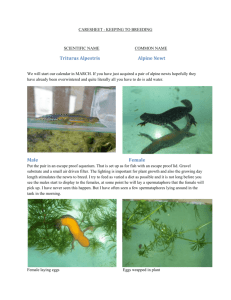
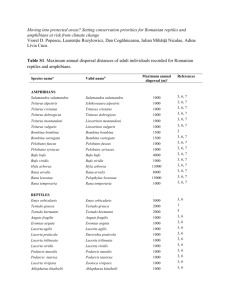

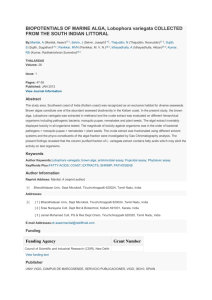


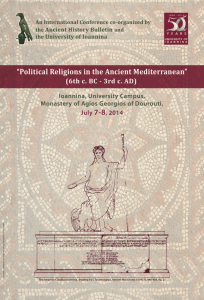
![Real-Life Climate Change Stories [WORD 512KB]](http://s3.studylib.net/store/data/006775264_1-25b312f26ec237da66580d55aa639ecf-300x300.png)
